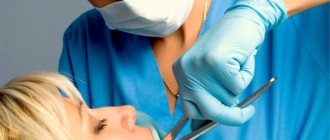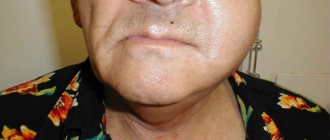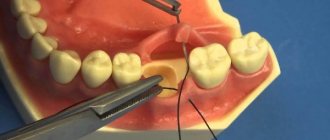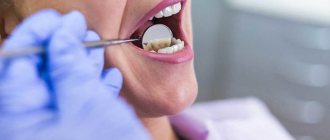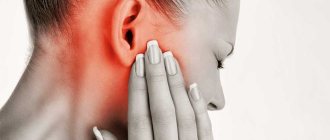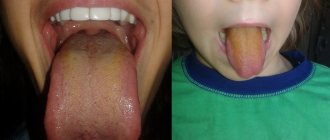I can’t open my mouth after removal - is this normal?
After the figure eight is removed, the patient may experience swelling in the place where the tooth used to be.
In some cases, the process is very intense and causes acute pain that appears when the mouth opens.
A person’s condition in which he cannot open his mouth or experiences significant difficulty in doing so is called trismus and is not considered a pathology. This is a normal phenomenon after surgery and does not require specific treatment.
Causes of trismus:
- An exacerbation of the inflammatory process in another tooth, which until the removal of the figure eight occurred in a latent form.
- Injury to the roots of adjacent teeth during surgery.
- Inflammation of the facial muscles involved in the chewing process.
- Damage to the temporomandibular joint.
- Dentist errors, which may be associated with an insufficient dose of anesthesia, incorrect position of the instrument, abnormal swinging, or extraction of the tooth with excessive force.
Difficult cases, after wisdom tooth removal it is painful to open your mouth
Painful sensations in the jaw joint after extraction of the third molar appear if the patient has a narrowing of the oral cavity of an acquired or hereditary nature.
Another reason for the discomfort that occurs when trying to open the mouth is the abnormal size of the jaw bone, which contributes to a disruption of the relationship between the mandibular apparatus and the temporal bone.
Pain syndrome in the jaw bone develops as a result of poor-quality extraction of the third molar.
Mistakes that a dentist makes during surgery include:
- Using a low-quality anesthetic drug. Extraction of the figure eight is a painful process: ignoring the anesthesia procedure leads to the development of an inflammatory process in the soft tissues.
- Violation of the technique of using dental forceps. The dentist must operate the instrument on the area that is located between the crown and the root in the direction of the axis of the dental element.
- Excessive force is applied to the jawbone during third molar extraction.
- Incorrect loosening of the eight. Multi-rooted dental elements, which include third molars, are loosened using the luxation method (rocking back and forth). The rotation method (swinging clockwise) is prohibited.
Traumatic circumstances that stimulate the complication of the process cause an intense pain reaction, along with persistent enlargement of the cheek for more than three days.
- If the mouth does not open after tooth extraction, maximum pain and swelling occurs on the second or third day. Even normally, the restriction can last up to 2-3 weeks.
- If, after tooth extraction, it is painful to open your mouth and there is a strong reaction, the problem must be addressed at a medical level. Since this means that many structures have been damaged and for the human system this is a shock that the body cannot cope with, or, on the contrary, triggers an enhanced resistance reaction.
But you can hear from patients that an hour ago they had their wisdom teeth removed and I can’t open my mouth almost immediately. This is because the onset of the reaction may be noted for the first time in the hours or in the late afternoon.
The reasons for the appearance of pain after extraction are obvious - this procedure is considered a microsurgical intervention in dentistry, and accordingly, its implementation entails partial injury to both the bone and soft tissues of the oral cavity. Damage to a blood clot in an empty socket can result in secondary infection of the wound and the development of a local inflammatory process.
It happens that as a result of a medical error or under the influence of other factors after surgery, pain, swelling appears, and an inflammatory process develops. Why such complications may occur:
- when carrying out manipulations by the doctor himself, the rules of asepsis and antisepsis were violated;
- the patient violated the recommendations given by the doctor after tooth extraction;
- insufficient quality of cleansing of the postoperative wound from pathogenic microorganisms by the dentist after extraction;
- allergies to medical products (drugs, materials) that were used during the manipulations;
- immune failure in the patient's body.
It happens that after tooth extraction, it is painful for the patient to open his mouth. This may be due to a number of factors. Thus, often after the extraction is completed, a so-called dry socket occurs (the main reasons are that the blood clot did not form or was removed when chewing hard, rough food).
If the mouth does not open after tooth extraction, the “culprit” of this pathology may be alveolitis - inflammation of the alveolar process, the cavity in which the tooth root was previously located. The main reasons for the development of the anomaly are insufficient oral hygiene by the patient after the procedure, damage to the blood clot in the socket, and violation of the rules of manipulation by the dentist.
Classic symptoms of maxillary alveolitis:
- a few days after extraction, a throbbing or aching pain occurs in the empty socket, which gradually increases;
- hyperthermia (body temperature rises above 38 degrees);
- there is a characteristic unpleasant odor from the mouth;
- the gums become painful when pressed;
- There may be a headache, a pain in the ear, the patient experiences general weakness, apathy, gets tired quickly, and drowsiness occurs.
When the mouth does not open after the removal of a wisdom tooth, purulent inflammation of the upper or lower jaw – osteomyelitis – may develop. The list of symptoms of this serious pathology includes: severe jaw pain, which only increases over time, swelling on the face at the site of the removed unit, hyperthermia, and deterioration in general well-being.
It happens that the mouth is difficult to open after extraction if the dentist damaged a nearby nerve during the work. The reason for this may be either the lack of experience of the doctor himself or the complex irregular shape of the tooth root.
If the mouth does not open after removal of a wisdom tooth, this may be due to increased functional load on the temporomandibular joint during the procedure (the patient is forced to sit for a long time with his mouth open; a mouth dilator is often installed).
What to do if the problem persists
Outside intervention in the body causes certain reactions, especially if the process was complex. Therefore, complex tooth extraction causes various side effects: swelling of the cheek, bleeding gums, fever. Patients complain of pain in the throat, ear, difficulty chewing and moving the jaws. Anomalies appear from damage to soft tissues. After all, the blood circulating there becomes free. It fills cavities, which leads to swelling. This is what prevents the patient from fully opening his mouth.
After conduction anesthesia, pathologies appear. Therefore, after wisdom tooth removal, it is painful to open your mouth and swallow. If the discomfort gradually subsides, this is normal and there is no need to worry. However, when the pain increases, becomes stronger every day, and does not go away for a long time, the patient must definitely visit a doctor. The sooner this is done, the faster and easier the therapy will be.
Re-cleaning the hole
If it hurts to open your mouth, a specialist should determine the cause of the abnormality. For this purpose, diagnosis is carried out and treatment is prescribed. Often, dentists in such situations clean the wound again. With curved roots, cysts can form and caries can develop, moving into an advanced phase. There are situations when the entire root cannot be removed at once. For the patient to recover, the surgeon must perform another cleaning. Also, this procedure is resorted to when a fragment is accidentally left behind. Pain and discomfort will go away when the wound is clean.
Physiotherapy
When the mouth is difficult to open and the jaw hurts, the following may be prescribed:
- Electrophoresis;
- Ultraviolet irradiation;
- UHF;
- Fluctuarization;
- Laser therapy;
- Magnetotherapy;
- Darsonvalization;
In addition to basic treatment, physiotherapeutic procedures accelerate healing. Complex therapy helps reduce the process of intense inflammation, eliminate discomfort, and fight pathogens.
Antibiotics
A common problem with Eights is dystopia. Since this provokes serious problems, a dystopic wisdom tooth in many cases must be removed. After all, such rudiments are located incorrectly. Their position is not vertical, but horizontal or inclined. Indications for extraction:
- Development of caries, pulpitis, periodontitis, when therapy does not bring a positive result;
- Serious damage to the unit located opposite;
- Impacted organ with inflamed mucous tissue;
- Orthodontic therapy of crowded anterior units;
Drug treatment for complications depends on the characteristics of the patient’s disease. If inflammation develops in the oral cavity, antibiotics are prescribed to eliminate the source of infection. This may be Lincomycin, Ciprolet, Dalacin, Amoxicillin or Ciprofloxacin. Antibacterial agents such as streptocide or sulfacyl can be used.
Jaw development with exercises
For patients with pain, doctors recommend rinsing with chlorhexidine, furatsilin, miramistin 24 hours after surgery. If the mouth does not open completely, the jaws should be developed. If you have difficulty moving, you need to help open the jaw with your fingers. It is important that the patient does not overdo it. Development is performed when the patient experiences mild pain. Gymnastics involves smooth opening of the mouth and soft chewing movements. The load increases gradually.
Full restoration of function will be noticeable after 15-20 days. Massage and heat therapy will help you recover faster. Moving a toothbrush with soft bristles improves blood circulation. Healing is accelerated by mud, paraffin, and ozokerite applications. In the first days, you need to exclude solid foods from your diet. It is useful to eat jelly, grated soups, and liquid porridges. On days 8-12, you can include regular dishes in the menu.
This is not a pathology, but a normal phenomenon
Frequent cases are those in which the mouth partially or almost completely does not open after the removal of a wisdom tooth. This occurs due to invisible microtrauma of the internal structures of soft tissues.
We suggest you read: Wisdom tooth hurts cheek - ProfiMed
We are talking about a normally performed procedure, without significant surgical damage. At the site where the last root is extracted, many small vessels pass through. During manipulation, at least minor damage occurs. The blood circulating in them is released and fills the tissues. As a result, swelling forms at the local level, which becomes the reason why the mouth does not open after tooth extraction.
That is, its functional ability is actually impaired and after the removal of a wisdom tooth, the jaw does not open. Within normal limits, the phenomenon disappears on the second day.
Thus, trismus is not a pathology, but a normal phenomenon that most patients in dental clinics encounter after surgery to remove a wisdom tooth. It takes time to normalize the patient’s condition, but at the same time you must strictly follow all the dentist’s recommendations.
Specifics of treatment for this unpleasant pathology
Removal of the figure eight is carried out in several stages and is determined by the type of placement in the bone. If the tooth is normally located in the bone, the specialist first performs anesthesia: conduction and, if necessary, infiltration. After this, the dental circular ligament is detached. This structure, presented in the form of connective tissue, connects the tooth with the gum located in the bone.
Then forceps are applied and rocking movements of small amplitude are made. Having made an imbalance, they slowly carry out withdrawal (traction). After this, the hole is checked with a curettage spoon, forming a clot for restoration, and the bone tissue of the maxillary alveolar process is compressed in the vestibulo-oral direction in order to prevent the occurrence of bone protrusions (exostoses). If the wisdom tooth is located in the position of retention and semi-retention, then the tactics of medical intervention are carried out differently.
We suggest you read: Tooth pain - why can’t you delay visiting a doctor?
The semi-retinated figure eight is determined visually in the oral cavity according to the following indicators:
- placement at an angle to the adjacent tooth;
- partial manifestation by tubercles 1_3;
- the unerupted part and the tubercles (partially) may be covered with a hood of mucous membrane;
- if prolonged pressure was applied to a nearby tooth, the latter changes in the form of the appearance of complicated forms of caries on its surface;
- X-ray shows angular placement in the bone and appears partially on the surface.
In most cases, an impacted wisdom tooth is determined during a panoramic examination, during which the direction of location in the bone and the expected defects of dental tissues are studied.
Extraction of the figure eight at the stage of semi-retention and retention is performed in the following order:
- Numbing the area.
- An incision is made from the vestibular side of the wisdom tooth with a scalpel to create a trapezoidal zone with the base facing downwards, detachment of the mucosal flap.
- Using a drill, a hole is drilled in the cortical plate of the bone, which corresponds to the position of the figure eight: during the procedure, they are guided by both the visual information of the oral cavity and the result of the radiographic examination. The drilled area is removed.
- The roots of the figure eight are cut with a milling cutter, if necessary, complementing the crowns and preparation. A layer-by-layer removal of parts of the wisdom tooth is performed.
- Curettage, antiseptic treatment, application of material to prevent the inflammatory process.
- The mucous patch is placed back, and sutures are fixed to the wound.
When any type of procedure is completed, the specialist will make a number of recommendations regarding home care.
Many people have difficulty opening their mouth after wisdom tooth removal.
The treatment procedure in the period after surgery is determined by the individual characteristics of the person and lasts from three to twelve days. At this time, in addition to strictly following the dentist’s recommendations, the patient needs to do gymnastic exercises for the jaw, trying to develop it.
Overcoming the pain, you need to open your mouth, imitating chewing movements. If the patient has severe swelling, herbal compresses should be applied. In addition, it should be noted that in the practice of dentists there are often cases when the negative consequences of wisdom tooth removal do not occur, and a person with pain opens his mouth only due to pain relief.
How does pathology manifest itself?
The main symptom indicating the presence of trismus (spasm of the jaw joint) is inadequate opening of the oral cavity. There are three degrees of the pathological process:
- In the first degree of trismus, the gap between the upper and lower dental arches is 4 cm.
- With the second degree of trismus, the gap between the jaw apparatus decreases to 2 cm.
- With the third degree of spasm, the oral cavity opens no more than 1 cm.
Joint pain is accompanied by swelling of the soft tissues, enlarged lymph nodes and fever. Some patients complain of constant dizziness, lack of appetite and poor sleep.
Other treatments
Treatment of pain in the jaw joint is complex and lasts from 5 to 12 days, depending on the degree of trismus. Surgery is considered the main way to relieve pain.
The cause of painful sensations after extraction of the third molar is a curved root system or an advanced carious process.
If these complications are present, the dentist cannot remove the entire root in one visit, so to completely remove it, the patient is prescribed a secondary cleaning of the socket. In order to eliminate the risk of side effects, the doctor uses conductive anesthesia during the repeated cleansing process.
Another indication for secondary treatment is the presence of a “dry” socket that cannot heal due to the absence of a blood clot. The reason for the drying out of the wound surface is its poor quality of cleansing, as a result of which the root residues fester. Removal of foreign elements is carried out using forceps.
Jaw pain as a symptom of infectious inflammation is an indication for taking antibacterial drugs. The use of antibiotics in the postoperative period is considered appropriate if the patient is diagnosed with an abscess or periodontitis.
In order to relieve pain in the jaw joint, the dentist prescribes broad-spectrum antibacterial agents:
- Lincomycin,
- Amoxiclav,
- Oletetrin,
- Vilprafen.
The duration of the treatment course and the dosage volume are determined by the dentist, taking into account the degree of trismus.
Painful sensations in the jaw joint, which are aggravated by the inflammatory process, suggest taking antimicrobial drugs - Sulfacil or Streptocide. If inflammation is accompanied by complications, the patient uses antiseptic drugs - Chlorhexidine, Furacilin, sea buckthorn oil.
To eliminate pain in the jaw joint, it is allowed to use non-traditional methods of treatment - massage, facial gymnastics and heat therapy. Massage performed with a soft toothbrush helps normalize local blood flow.
Therapeutic gymnastics involves regular development of the jaw apparatus by simulating the chewing process. In order to speed up the healing process of the hole, the patient is allowed to use applications impregnated with paraffin or ozokerite.
Is it normal if your mouth does not open after wisdom tooth removal? How can I solve the problem?
Wisdom tooth removal is a common and difficult procedure. The difficulty in performing it is associated with the structure of the figure eights and their remote location in the mouth.
Side symptoms may appear even if all the dentist’s recommendations are strictly followed.
https://www.youtube.com/watch?v=bMk1VdR0Zcs
Trismus, a painful sensation and inability to open the mouth, is considered a fairly common side effect. Is it dangerous?
A patient facing such a limitation undergoes the following manipulations when visiting a dentist:
- The doctor performs a general examination of the oral cavity.
- Reveals the degree of restriction.
- Performs antiseptic treatment and other necessary procedures.
Photo 1. First of all, the dentist conducts a general examination of the patient’s oral cavity, then identifies the degree of restriction in mouth opening.
Depending on the general condition, after examination the patient may be given some recommendations:
- The use of non-steroidal anti-inflammatory drugs to relieve inflammation in the area of intervention.
- Physiotherapeutic procedures: UHF, electrophoresis, laser.
- Conducting special gymnastics.
If the appearance of trismus is associated with normal reactions of the body to the operation performed, the patient is recommended to perform gymnastics to develop and restore jaw mobility.
Important! Before performing procedures, consultation with a doctor is required.
Gymnastics involves gradually opening and closing your mouth throughout the day.
Also, the patient is sometimes advised to chew gum and combine manipulation with rinsing with herbal solutions.
Gymnastics can only be done if the spasm is not accompanied by acute pain.
It is strictly forbidden to exert force and stretch the jaws.
Immediately after removal or after a few hours, the place where the wisdom tooth was previously located swells. In some patients this process is very intense. This causes pain when opening the mouth. A condition in which it is difficult or impossible to open the mouth is called trismus or tonic muscle spasm in dentistry.
Wisdom tooth removal
Trismus is usually not a pathology. This is a normal postoperative phenomenon that does not require specific treatment. The mechanism for the appearance of trismus is associated with damage to the tissues of the oral cavity, with muscle tension (if the patient keeps his mouth open for a long time). Also, during removal, blood vessels and nerves are affected, swelling and pain occur - this causes difficulty opening the mouth.
This condition goes away on its own after 1-3 weeks. To speed up, it is allowed to carry out special gymnastics.
In what cases is it difficult to open the mouth due to serious and dangerous complications of removal?
- Another tooth is affected by periodontitis or chronic latent pulpitis. Such inflammation could be asymptomatic and worsen after removal of the eight.
- The roots of adjacent teeth are intertwined and closely spaced. When wisdom teeth were removed, they were injured and acute pulpitis developed.
- The facial muscles that are involved in the chewing process are inflamed.
- Damage to the temporomandibular joint.
- A number of dentist mistakes include insufficient pain relief, incorrect application of the instrument, disturbances in rocking, and forceful removal of the tooth.
We suggest you read: Redness of the skin in the corners of the lips
Signs of this pathology and the reasons for their appearance
The condition in which the jaw cannot be opened after tooth extraction is a normal reaction of the body in the period after surgery. Swelling in most cases goes away within three to four days, pain decreases already on the second day after the procedure. If acute pain appears against the background of high body temperature, persistent swelling and a putrid odor coming from the mouth, you should seek qualified medical help.
We suggest you read: Ultrasonic removal of wisdom teeth
What to do if it hurts to open your mouth after tooth extraction?
Features of wisdom teeth extraction
The procedure depends on the location of the figure eight in the bone. If it is in the standard position, the dentist performs anesthesia, after which he performs a detachment of the circular ligament.
The next step is to apply forceps and gently rock the tooth. When it is unbalanced, the doctor removes it.
The final stage of manipulation is disinfection, creation of a clot for regeneration and insertion of medicine.
If the number eight exhibits semi-retention or retention, removal becomes significantly more difficult. This procedure will require cutting soft tissue, drilling out the remains of the tooth and root, and suturing the gum. As a result of such intervention, the recovery period increases and the risk of complications increases.
The procedure depends on how the figure eight is located in the bone. If the position and growth are normal, anesthesia is first performed, then the circular ligament is detached, then the doctor applies forceps and performs gentle rocking movements.
After the tooth is unbalanced, traction is carefully performed - extraction. Final manipulations - disinfection, creating a clot for regeneration, adding medicine (if necessary). If semi-retention or retention of a tooth is observed, its removal is complicated.
Eights extraction
Removal of a wisdom tooth is performed in several stages, depending on the nature of the location of the bone. If it is placed naturally, an anesthetic is injected, after which the ligament around the tooth gradually peels off. The tissue connects the tooth to the gum, after which forceps are applied to the figure eight and gradually rocked. The tooth is removed after such an imbalance.
According to statistics, 25-30% of people experience pain after surgery to remove a wisdom tooth. 3-5% experience inflammation after the removal of any other teeth. This is due to the fact that the removal of wisdom teeth is a more complex procedure compared to the removal of ordinary teeth. The fact is that the figure eights are surrounded by a lot of soft tissue.
The severity of painful symptoms directly depends on the traumatic nature of the removal. The patient's condition is influenced by factors such as the position of the tooth and, no less, the degree of qualification of the dental surgeon and the instruments he uses.
Medical recommendations
It is important for the patient to remember that on the first day after the procedure, solid food and stress on the jaw are prohibited. At this time, a light diet (soups, cereals, jelly) is recommended. You can return to a normal diet and work your jaw intensively only from 6-7 days after removal. Also, on the day of removal, you should not brush your teeth.
Immediately after removal, hot drinks, visiting baths, saunas are prohibited - pathogenic microflora in the hole will begin to actively multiply or bleeding will begin. Exercising or drinking alcohol can also cause bleeding.
For the first 2 days, you should not rinse your mouth, as the removal site should heal. When the hole dries, you can make baths with chamomile, sage, baking soda - take the infusion into your mouth and hold it on the sore side, do not rinse.
After removing the figure eight, the patient should be prepared for some possible side effects. During the recovery period, it is important to monitor your condition and contact your dentist if suspicious symptoms appear. If it is difficult to open your mouth after removal, you first need to find out the reason, and then take measures to eliminate the problem.
Our expert dentist will answer your question within 1 day! Ask a Question
Since extraction of the third molar leads to damage to the jaw joint, doctors recommend following a light diet for the first three days after surgery, which is based on avoiding hard foods. Starting from the fourth day, it is allowed to add solid foods to the diet consisting of cereals and soups and increase the chewing load.
Do you feel nervous before visiting the dentist?YesNo
In order to eliminate the risk of infection of the affected hole or the development of bleeding, the patient must refrain from visiting the gym and bathing procedures, as well as from drinking alcoholic beverages.
Dentists recommend refraining from rinsing for two days after wisdom tooth removal to allow the hole to heal. After the wound surface has dried, it can be treated with a decoction of chamomile and sage, soda solution or Furacilin.
How to solve the problem
If it hurts to open your mouth after wisdom tooth removal, of course, you should visit the dentist again - ideally as soon as possible. He will examine the site of the extracted tooth and take a panoramic photo to determine exactly what is causing the condition. If necessary, the following treatment is carried out:
- repeated cleaning and disinfection of the hole;
- physiotherapy: UHF, electrophoresis, laser;
- antibiotic therapy;
- treatment or removal of an unhealthy antagonist tooth, if the cause of muscle spasm, swelling and pain is in it.
If, after tooth extraction, it hurts to open your mouth, but no complications were identified, you should just be patient and gradually develop your jaw at home.
We suggest you read: Smoker's plaque: causes, symptoms, how to remove
In the first days after surgery, in any case, you should not eat solid food or put any strain on your jaw. You may have to stay a little longer on a gentle diet consisting of pureed soups, liquid porridges and jelly. But on days 6-7, you should gradually return to normal eating and try to gradually open your mouth and chew.
Doctors recommend developing trismus while it is fresh. The more time after surgery passes without development, the more difficult it will be to restore the functionality of the jaw later. This does not mean that you need to endure hellish pain and forcefully open your mouth, torturing yourself. But throughout the day, you should carefully and little by little constantly open and close your mouth, each time at a greater distance. You can chew gum, but not too intensely.
After removal of the third molar, the patient should be prepared for some side effects, which the doctor usually warns about. During the recovery period, you should carefully monitor your condition and, at the slightest suspicious symptoms, do not hesitate to consult a doctor.
What happens when you clean the hole again?
In a situation where a person’s figure eight roots are bent or a cyst has formed in the oral cavity, the dentist cannot perform the entire operation at one time.
For final recovery, another procedure is required - repeated cleaning of the hole. Only after this manipulation will the patient get rid of pain and discomfort.
Reference! As a rule, conduction anesthesia is prescribed for repeated cleaning.
Taking antibiotics
Depending on the individual characteristics of the person and the nature of the disease, the dentist may recommend additional drug therapy:
- If the muscle spasm was caused by a neurotic factor, the patient is prescribed sedatives.
- When the cause of trismus is an inflammatory reaction, the dentist prescribes antibiotics that will eliminate the infection.
Most often, the attending physician prescribes Amoxicillin, Lincomycin, Tsiprolet or Dalacin C.
Attention! The necessary medicine must be prescribed by a doctor! Self-medication can lead to serious consequences.
General recommendations
For a quick recovery, it is important to follow certain rules:
- Do not eat or drink for at least 3 hours after the procedure.
- Stop taking blood thinning medications (Aspirin, Cardiomagnyl) for 3 days.
- Maintain good oral hygiene (rinse regularly, use dental floss).
- Avoid drinking alcohol for 3 days after surgery (minimum).
- Follow all dentist recommendations.
- Do not brush your teeth for two days.
- Do not touch the hole of the removed eight with your tongue.
- Do not eat hot or cold food.
- Avoid general hypothermia of the body.
- Do not put cotton wool or homeopathic sponges into the hole without a doctor’s recommendation.
- Do not visit the steam room or take a hot bath.
What to do in such a situation?
If you feel pain and discomfort, you should make a follow-up visit to your dentist. After examining the site of the extracted tooth and taking a panoramic photo, the doctor will identify the cause of the pain and may prescribe treatment:
- Cleaning and disinfecting the hole.
- Procedures using laser, electrophoresis, UHF.
- Prescribing a course of antibiotics.
- Treatment or removal of a tooth that is causing spasm and pain.
There are cases when pain after wisdom tooth removal, pain or swelling in the jaw are not associated with any complications - you just have to be patient for a while and gradually develop the jaw on your own.
Do not forget that for the first time after surgery it is necessary to exclude any solid food so as not to put too much strain on the jaw.
A gentle diet, which involves eating liquid cereals, soups, jelly, purees and other liquid foods, lasts no more than 5-6 days, after which you can gradually return to your normal diet.
Experts advise treating trismus immediately, since after some time it will be much more difficult to restore the functionality of the jaw. Of course, everything should be done carefully. Open and close your mouth a little, each time wider and wider. You can chew gum, but not too intensely.
When the mouth does not open after extraction of the figure eight, you need to come back to the dentist. It's better not to delay this. The specialist will conduct an examination and take a photo to more accurately determine the difference in this condition.
If necessary, the following treatment procedures are carried out:
- Cleaning and disinfection.
- Physiological procedures: UHF, laser, electrophoresis.
- Antibiotic therapy.
- Elimination of an unhealthy tooth if it provokes spasms, pain and swelling.
We suggest you read: Dry socket after tooth extraction
If no symptoms are detected, but it still hurts to open your mouth, you need to gradually develop your jaw.
Why does my jaw hurt after tooth extraction?
Together with the tooth, the dentist removes the nerve located in it. At the same time, the nerve endings that penetrate the periodontium and gums remain intact. It is due to their irritation that the jaw hurts after tooth extraction. If the jaw hurts for 4 to 7 days after tooth extraction, this is considered normal.
The exact figure depends on the following factors:
- the complexity of the surgical intervention performed (which tooth was removed - incisor, small or large molar units), the general condition of the bone and surrounding soft tissues, the size of the tooth root plays a role;
- how well the patient follows the dentist’s recommendations for caring for the oral cavity after extraction (if all procedures are performed, the jaw or soft tissues should not hurt at all);
- the doctor’s experience (how carefully and professionally the manipulations were carried out);
- equipment of the dental clinic (the more modern the equipment, the lower the risk of postoperative pain);
- After wisdom tooth removal, the jaw hurts in people with a low pain threshold.
It takes time to develop the jaws after the figure eight is removed. The time period for the spasm to be relieved varies from person to person, usually from a week to a month. The jaw muscles should be developed as quickly as possible. Slowly open and close your mouth more often, increasing the load daily, avoiding severe pain. Prefer soft foods to hard ones. If the discomfort does not subside over time, visit the dentist who performed the resection.
We suggest you read: Antibiotic treatment for inflammation of the gums and tooth roots, antibiotics for gingivitis
The surgeon will conduct an external examination and determine the degree of restriction of opening and closing. Prescribe treatment in the form of:
- anti-inflammatory drugs (Furacilin, Rotokan, Chlorhexidine, sea buckthorn oil);
- physiotherapy (electrophoresis, laser, UHF).
You can visit an osteopathic doctor. Mastering a certain technique of influencing vital points of the body with the help of his hands, he will help to quickly relieve spasms from the damaged area, activating and restoring the body’s strength without medications.
The medical practice of dentists and the experience of patients shows that when faced with the problem of wisdom tooth removal, surgery can rarely be avoided (see also: how long does your gum hurt after wisdom tooth removal?). However, modern diagnostic methods (radiography), fairly safe, painless use of anesthesia during surgery and a trusting relationship with the surgeon will allow us to solve this problem quickly and effectively.
Pain during wisdom tooth eruption -
Pain during wisdom tooth growth occurs in almost every patient. The crown part of a wisdom tooth completes its formation by the age of 12, and the end of the formation of roots usually occurs at the age of no earlier than 24 years. The eruption of wisdom teeth most often begins during the formation of roots - between the ages of 18 and 21 years. But with the same success, teething can begin at the age of 14 or at the age of 40 (or even much later, for example, immediately after the removal of the 7th tooth in front).
The duration of teething symptoms will depend on - 1) on the availability of free space in the dentition, 2) on the position of the wisdom tooth in the bone tissue of the jaw. For example, if it has a strong inclination towards the seventh tooth (as in the x-ray above), then the wisdom tooth will rest against it with a crown and will not be able to erupt completely. In this case, only a small part of the crown will protrude above the surface of the mucous membrane. But at the same time, as soon as part of the tooth erupts through the mucous membrane, conditions are created for inflammation of the gums above the wisdom tooth. And this process of eruption can last for years.
1) Inflammation of the hood above the wisdom tooth -
The mucous membrane hanging over the crown of the erupting wisdom tooth is called the “hood” (Fig. 1).
Inflammation of the hood occurs when a wisdom tooth erupts through the mucous membrane with one or more crown cusps. Those. a situation arises when the chewing surface of the tooth crown is already partially open, and the remaining part is still covered by the mucous membrane. Between the hood and the chewing surface of the tooth crown, favorable conditions are created for the growth of bacteria, which cause inflammation of the gums above the wisdom tooth. If your gums hurt near your wisdom tooth, then most likely this is due to inflammation of the hood (Fig. 2-3). This disease also has the official name "pericoronitis". In Fig. 4 you can see the main cause of inflammation of the gums at the wisdom tooth, associated with the difficulty of hygiene in this hard-to-reach area of the oral cavity.
What to do if the hood is inflamed - with minor inflammation (provided that there is no pus coming out from under the hood), you can try to cope with the inflammation yourself. To do this, you will need a complex consisting of antiseptic rinses and anti-inflammatory gel applications, which we will discuss below.
In parallel with their use, it is advisable to start taking analgesics from the NSAID group (non-steroidal anti-inflammatory drugs). These include drugs, for example, based on ibuprofen. The peculiarity of drugs in this group is that they have both anti-inflammatory and pronounced analgesic effects. Therefore, we recommend that they supplement local therapy in the oral cavity, consisting of the following drugs:
- antiseptic rinses with 0.05% Chlorhexidine solution,
- applications with Cholisal-gel.
Treatment is carried out 2-3 times a day: in the morning after breakfast and brushing your teeth, in the evening (before bed) after brushing your teeth, and also in the middle of the day. First, you need to rinse your mouth with a Chlorhexidine solution for 1 minute (the solution is sold ready-made at the pharmacy, costs 20-30 rubles), then dry the surface of the hood with a dry gauze swab and apply the gel to it with your finger. After this, do not eat for 2-3 hours and do not rinse your mouth.
If the inflammation is significant - in which cases should you immediately go to the dentist - 1) if there is discharge of pus from under the hood, for example, when pressing on it, 2) there is significant swelling and swelling of the gums, 3) there is painful swallowing or difficulty opening the mouth, 4 ) if swelling of the cheek has already appeared, 5) if an elevated temperature occurs. All these situations indicate suppuration and the risk of complications, and therefore you should immediately contact a dental surgeon.
Of course, you can again try to reduce inflammation with rinses, anti-inflammatory gels, antibiotics, but the effect of these measures will only be temporary, or it will not exist at all. Treatment in this case should consist of excision of the hood over the wisdom tooth. This procedure is performed under local anesthesia and lasts only a few minutes. And after this, rinsing with Chlorhexidine and applications of Cholisal-gel (or, as an alternative, Metrogyl denta gel) are usually prescribed.
Pericoronitis and excision of the hood (video 1-2) –
2) Pain due to difficult eruption of wisdom teeth –
Very often, when a wisdom tooth erupts, there is simply not enough space, and in this case, eruption usually turns into a long and not very unpleasant process.
In this case, the 8th tooth rests on the seventh tooth in front, pressing on it, which leads to a gradual displacement of all the teeth in front. This process is similar to orthodontic intervention (moving teeth with braces), and is also accompanied by discomfort and pain. But difficult eruption can also occur in the case when there is enough space for the eruption of a wisdom tooth. To do this, the wisdom tooth just needs to have a strong tilt towards the crown of the 7th tooth. In this case, the eighth tooth will rest with its crown - on the neck of the 7th tooth, which will not allow it to erupt completely (see x-ray below). By the way, such teeth with difficulty erupting are called “impacted.”
What to do - in such situations there is a very high risk of both the appearance of crowded teeth and the destruction of the crown of the 7th tooth. Therefore, wisdom teeth are often removed to prevent such consequences. It is quite easy to predict whether or not a particular person will have crowded teeth. To do this, you need to correctly assess the length of the body of the lower jaw and the sufficiency of space for all teeth, including wisdom teeth, as well as their correct position in the jaw.
Horizontal position of the wisdom tooth –
→ Indications for removal of eighth teeth → How wisdom teeth are removed
Solution
Already on the second day after extraction, it is useful to rinse your mouth with various compositions, but which ones should be decided by the dentist. Among the most popular means it is worth highlighting:
- Chlorhexidine.
- Miramistin.
- Soda-salt solution.
- Infusions of chamomile, eucalyptus, calendula.
- Furacilin (available in bottles with a ready-made solution and tablets - 2 pieces diluted in a glass of water, rinse the mouth).
Rinsing is carried out as follows: take a small amount of the required solution into the mouth, hold it near the empty well for 2-3 minutes, and spit it out. In the first few hours after extraction, you should refrain from eating. This is especially true for hot foods, which can irritate the postoperative wound and cause pain at the site of the extracted tooth.
The list of additional nutritional recommendations includes the following: eating only soft (preferably crushed, grated) food, avoiding sweets and baked goods, not drinking drinks through a straw, avoiding alcoholic beverages and not using toothpicks. If pain occurs in the lower (upper) jaw after tooth extraction, and in addition the empty socket bleeds, it is recommended:
- apply a cotton (gauze) swab to the hole, press it, hold it for 3-5 minutes - the bleeding should stop;
- You can apply a cold compress to the cheek on the side of the extracted tooth.
If pain after extraction is associated with alveolitis, the dentist in his office performs the following manipulations:
- pain relief (injections of Novocaine, Lidocaine);
- removes an infected blood clot, cleans the socket;
- treats the cavity with antiseptic solutions;
- A protective tampon soaked in the medicinal composition is placed in the hole.
Next, at home, the patient should rinse his mouth with antiseptic solutions; if indicated, the dentist will prescribe antibiotics. Treatment of osteomyelitis is surgical followed by antibiotic therapy.
According to statistics, most dental complications occur after the removal of a wisdom tooth, the so-called figure eight. If the nerve is damaged, the unpleasant symptoms go away on their own within a few days, but if recovery does not occur, the dentist prescribes physiotherapy.
Painkillers (Analgin, Tempalgin, Ketarol, Solpadeine) will help relieve pain in the TMJ after extraction. If after tooth extraction the mouth does not open for quite a long time, and pain is felt in the jaw and in the area of the extracted tooth, and the gums next to the socket are swollen, it is recommended to seek help from a dentist, take an x-ray, and, if necessary, carry out the necessary treatment.
If, after the figure eight removal procedure, you experience difficulty opening your mouth, a second consultation with your dentist is necessary. The specialist will accurately determine the cause and prescribe measures to eliminate the problem. To alleviate the condition, you may need to re-clean the socket, physiotherapy, take antibiotics or special exercises.
A socket is an open cavity that remains after molars are removed. Repeated cleaning may be necessary if there is a dry socket, the area does not heal, or becomes inflamed, which causes difficulty opening the mouth. During repeated cleaning, the dentist performs a number of manipulations:
- checks whether roots remain inside;
- treats with antibacterial drugs;
- closes the hole with a sterile swab.
Physiotherapy
How can I solve the problem?
If, after the figure eight removal procedure, you experience difficulty opening your mouth, a second consultation with your dentist is necessary. The specialist will accurately determine the cause and prescribe measures to eliminate the problem. To alleviate the condition, you may need to re-clean the socket, physiotherapy, take antibiotics or special exercises.
Re-cleaning the hole
Hole after wisdom tooth removal
A socket is an open cavity that remains after molars are removed. Repeated cleaning may be necessary if there is a dry socket, the area does not heal, or becomes inflamed, which causes difficulty opening the mouth. During repeated cleaning, the dentist performs a number of manipulations:
- checks whether roots remain inside;
- treats with antibacterial drugs;
- closes the hole with a sterile swab.
If there are roots left inside, they must be removed immediately, as they may begin to rot. For removal, dentists use tweezers or a scalpel to cut through the gums. Then a repeat x-ray is prescribed to determine the cleanliness of the hole. A clean hole heals after 2 weeks.
Physiotherapy
Ultraviolet (UVR)
Irradiation of the well with a spectrum of rays. Start with 2 and end with 6 biodoses. The course of treatment is 4-6 treatments.
Result:
- Reducing the virulence of bacteria.
- Activation of regeneration processes.
- Anti-inflammatory effect.
Fluctuarization
It is carried out in conjunction with the Ural Federal District. The well is exposed to the first form of current. Drug electrophoresis of anesthetics (usually Trimecaine). The session lasts 20 minutes, the number of repetitions is 6. Reduces pain and relieves swelling.
Laser therapy
Infrared exposure in the oral cavity for 1-2 minutes. Course – 2-3 repetitions. Reduces inflammation, reduces swelling and tissue hyperemia.
Physiotherapy
Magnetotherapy
Exposure to magnetic field. Course – 20 procedures. The duration of one is 25 minutes. Relieves severe pain.
Antibiotics
Medicines in this group are prescribed only in the presence of an infectious-inflammatory process at the site of wisdom tooth extraction. Antibiotics are also indicated if at the time of the procedure the patient had an abscess, gumboil, or periodontitis. Medicines will also help eliminate complications after the intervention. Dentists prescribe broad-spectrum antibiotics:
- Amoxiclav;
- Vilprafen;
- Lincomycin;
- Neomecin;
- Olethetrin.
Lincomycin
Other actions
If trismus is caused by a normal reaction of the body, it is recommended to develop and restore jaw mobility. Before performing such gymnastics, consultation with a dentist is required. Throughout the day, you need to carefully open and close your mouth, more and more each time.
You can chew gum, but not very intensely. Trismus can develop only with mild painful sensations. You can combine exercises with rinsing your mouth with herbal solutions.
You can unclench and open your jaws only when trismus is a normal phenomenon and is not accompanied by acute pain. Making efforts, applying force, or stretching the jaws is prohibited.
Folk remedies
At home, proven home recipes will help you cope with a sore throat, under the jaw, and in the area of the inflamed hole. Thus, a decoction of chicory root relieves inflammation, eliminates pain, and has antiseptic properties. Rinse your mouth with this remedy (1 teaspoon per glass of warm water) up to 6 times a day.
For pain in the TMJ, applications with aloe and kalanchoe help. These plants are hypoallergenic, provide drainage of pus, if any, and soothe inflammation. Apply compresses to the “affected” side 3-4 times a day for 3-5 minutes. You can apply garlic pulp, previously diluted with warm water, to the inflamed hole (leave for 10–15 minutes, after which it is recommended to rinse your mouth additionally).
Precautionary measures
What to do after molar extraction:
- avoid intense physical activity (at least for the first 2 days);
- refuse to eat for several hours after surgery;
- you cannot chew food on the side from which the tooth was removed for 2–3 days;
- It is recommended to stop drinking alcohol (they irritate the already “restless” mucous membrane);
- Do not touch the empty socket with your finger, toothbrush, toothpick or any other foreign object - this can damage the blood clot that has formed in it, without which “healthy” postoperative healing is impossible;
- It is useful to rinse your mouth (for example, with a soda solution), but you should not carry out this procedure on the first day after extraction;
- If your jaw hurts severely after wisdom tooth removal, you can, on the doctor’s recommendation, take a painkiller tablet (Analgin, Paracetamol, Ibuprofen).
So, it happens that after tooth extraction the jaw hurts or does not open. This is due to the fact that during the procedure or after it, certain postoperative complications arise. How long can the jaw hurt after tooth extraction: pain for a week after the operation is a phenomenon that is usually considered as a variant of the norm.
If discomfort persists for a longer period of time, it is necessary to seek help from a dentist - such symptoms may indicate alveolitis, osteomyelitis, damage to the TMJ, various pathological processes of an infectious-inflammatory nature in the oral cavity, or be the result of one or another medical error. In any case, timely elimination of the pathological process will avoid the unpleasant consequences of extraction.
Why does wisdom tooth hurt?
Wisdom teeth almost always grow crooked. Problems with teething are dictated by the following anatomical features:
- “Eights” appear later than all other teeth. As a rule, the jaw bones are fully formed, the dentition is stable, and the “newbie” simply does not have enough space;
- The third molars do not have milk “predecessors”, and the rudiments of wisdom teeth developed for too long and not in very favorable conditions. Because of this, they erupt chaotically, damaging the adjacent tooth or causing inflammation of the gums.
When talking about the causes of pain associated with one or more molars, it is worth distinguishing between some concepts. Toothache can occur against the background of abnormal eruption, due to deformations of soft tissues of neighboring teeth. This clinical picture is typical only for “eights”; other teeth are cut much more smoothly.
Causes
However, the cause of toothache may also lie in fairly classic causes associated with common dental pathologies: caries, periodontal disease or periodontitis. If you systematize all the reasons that cause tooth pain, you will get the following list:
- The wisdom tooth rests too much on the tissues of the oral cavity, squeezing and injuring them;
- The tooth is rotated around its axis. The greater the angle of rotation, the more tense the dental nerve is, which provokes pain;
- Carious cavities have formed on the surface of the wisdom teeth; if they reach the dental tissues, the pain will intensify;
- Tartar deposits have formed, which rub the gums and cause inflammation;
- Due to the fact that the rapid growth of the “eight” and crooked eruption damaged the root system of the neighboring molar, it is this neighboring tooth that hurts;
- If the wisdom tooth, due to its incorrect position, begins to pinch the jaw nerve, pain occurs in the lower jaw. In this case, neuritis manifests itself in this way;
- A follicular cyst has formed at the neck of the tooth. It often occurs against the background of permanent damage to the gum tissue and the tooth itself.
It is worth noting the fact that a follicular cyst near wisdom teeth is often accompanied by all sorts of complications. For example, an abscess may occur that can even deform the jaw in a neglected state. The periodontal tissues may also become inflamed and pericoronitis may develop.
Inflammatory processes of the tissue covering the wisdom tooth
Inflammation of the hood is a common phenomenon. If a wisdom tooth erupts through several crown cusps at once, phenomena may occur when the chewing surface of the crown is partially covered by tissue. The part of the gum and mucous membrane that overhangs the molar and is called the hood. He is constantly susceptible to injury and prone to inflammation.
Under the surface of the hood, particularly favorable conditions arise for the accumulation of various biological “garbage” and the proliferation of pathogenic bacteria. Often even the slightest damage causes irritation. The gums around the “eight” may not hurt much, so they don’t always turn to people with such a problem.
However, if the inflammatory process is severe, the tissues not only swell, but are also irritated. The patient complains of painful swallowing, sometimes it is difficult even to simply open his mouth. There may be pus and severe hyperemia on the gum near the wisdom tooth. Only a doctor can save you from such an obsessive and severe dental inflammation by excision of the hood.
Lack of space during teething
If there is not enough space for the wisdom tooth in the dentition, neighboring tissues are injured during eruption. The pain is total. It hurts not only the place where the molar erupts, but also the neighboring teeth. Swelling, hyperemia, and severe pain that are permanent may also be observed. It is difficult for the patient to open his mouth, especially if the “eights” grow in the direction opposite to the jaw. Such teeth must be removed. This is due to the fact that a crooked tooth can damage the entire dentition, up to its noticeable curvature.
Caries
If a wisdom tooth is affected by caries, the first symptom indicating the disease will be pathological increased sensitivity of the teeth. They will react painfully to any irritants - sour, spicy, salty foods, sweets, cold irritants.
Situations often occur when the curvature of a wisdom tooth injures the neighboring tooth, which causes caries in it. The most dangerous situation is when the “eight” damages the root of the neighboring “seven”. Caries develops just below the gum, and the doctor is not always able to visually identify the carious lesion. At the same time, a severely advanced form of “root” caries is difficult to treat and the tooth can almost never be saved.
Pulpitis
In acute pulpitis that affects the wisdom tooth, patients complain of acute pain that occurs in attacks. The disease and its main manifestations are characterized by a spontaneous nature. Unpleasant sensations can occur spontaneously and last up to 15 - 30 minutes. At night the pain intensifies.
In the chronic form of wisdom tooth pulpitis, the pain is not so pronounced. Unpleasant, aching sensations occur against the background of exposure to cold or heat. If the irritant is removed, the pain continues for some time.
Periodontitis
Periodontitis is characterized by aching pain that constantly worries the patient. At the same time, the diseased tooth will react to any irritant with acute pulsating, shooting pain. Slight mobility of the affected tooth is also noted, and swelling and soreness of the gums are often observed.
It is interesting that with chronic periodontitis the pain is almost not disturbing. Very minor unpleasant sensations can only appear when the “figure eight” is tapped on the patient’s tissues.
